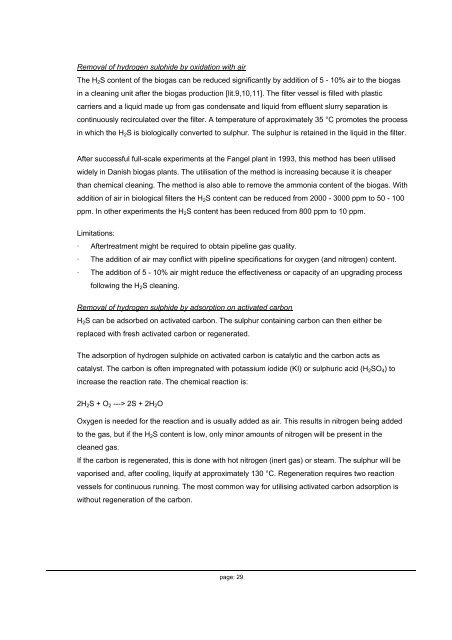Adding gas from biomass to the gas grid - SGC
Adding gas from biomass to the gas grid - SGC
Adding gas from biomass to the gas grid - SGC
- No tags were found...
Create successful ePaper yourself
Turn your PDF publications into a flip-book with our unique Google optimized e-Paper software.
Removal of hydrogen sulphide by oxidation with airThe H 2 S content of <strong>the</strong> bio<strong>gas</strong> can be reduced significantly by addition of 5 - 10% air <strong>to</strong> <strong>the</strong> bio<strong>gas</strong>in a cleaning unit after <strong>the</strong> bio<strong>gas</strong> production [lit.9,10,11]. The filter vessel is filled with plasticcarriers and a liquid made up <strong>from</strong> <strong>gas</strong> condensate and liquid <strong>from</strong> effluent slurry separation iscontinuously recirculated over <strong>the</strong> filter. A temperature of approximately 35 °C promotes <strong>the</strong> processin which <strong>the</strong> H 2 S is biologically converted <strong>to</strong> sulphur. The sulphur is retained in <strong>the</strong> liquid in <strong>the</strong> filter.After successful full-scale experiments at <strong>the</strong> Fangel plant in 1993, this method has been utilisedwidely in Danish bio<strong>gas</strong> plants. The utilisation of <strong>the</strong> method is increasing because it is cheaperthan chemical cleaning. The method is also able <strong>to</strong> remove <strong>the</strong> ammonia content of <strong>the</strong> bio<strong>gas</strong>. Withaddition of air in biological filters <strong>the</strong> H 2 S content can be reduced <strong>from</strong> 2000 - 3000 ppm <strong>to</strong> 50 - 100ppm. In o<strong>the</strong>r experiments <strong>the</strong> H 2 S content has been reduced <strong>from</strong> 800 ppm <strong>to</strong> 10 ppm.Limitations:· Aftertreatment might be required <strong>to</strong> obtain pipeline <strong>gas</strong> quality.· The addition of air may conflict with pipeline specifications for oxygen (and nitrogen) content.· The addition of 5 - 10% air might reduce <strong>the</strong> effectiveness or capacity of an upgrading processfollowing <strong>the</strong> H 2 S cleaning.Removal of hydrogen sulphide by adsorption on activated carbonH 2 S can be adsorbed on activated carbon. The sulphur containing carbon can <strong>the</strong>n ei<strong>the</strong>r bereplaced with fresh activated carbon or regenerated.The adsorption of hydrogen sulphide on activated carbon is catalytic and <strong>the</strong> carbon acts ascatalyst. The carbon is often impregnated with potassium iodide (KI) or sulphuric acid (H 2 SO 4 ) <strong>to</strong>increase <strong>the</strong> reaction rate. The chemical reaction is:2H 2 S + O 2 ---> 2S + 2H 2 OOxygen is needed for <strong>the</strong> reaction and is usually added as air. This results in nitrogen being added<strong>to</strong> <strong>the</strong> <strong>gas</strong>, but if <strong>the</strong> H 2 S content is low, only minor amounts of nitrogen will be present in <strong>the</strong>cleaned <strong>gas</strong>.If <strong>the</strong> carbon is regenerated, this is done with hot nitrogen (inert <strong>gas</strong>) or steam. The sulphur will bevaporised and, after cooling, liquify at approximately 130 °C. Regeneration requires two reactionvessels for continuous running. The most common way for utilising activated carbon adsorption iswithout regeneration of <strong>the</strong> carbon.page: 29
















